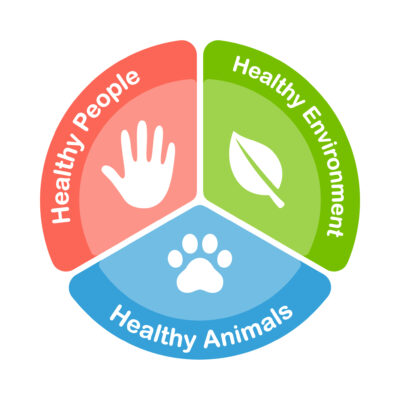One Health

Understanding the One Health approach, how it connects humans, animals, and the environment, and what it means for your dog or cat.
Chances are, you’ve come across references to “One Health” and wondered what it means. This concept has been around since the early years of the 21st century, but what is it all about, and how does it impact your dog or cat? Read on to learn more.
One Health 101
According to the US Centers for Disease Control (CDC), One Health is a collaborative, multisectoral, and transdisciplinary approach — working at local, regional, national and global levels — with the goal of achieving optimal health outcomes that recognize the interconnection between people, animals, plants, and their shared environment.
 The so-called One Health Triad shows how the health of people, animals and the environment are linked to one another, and is a worldwide concept that helps all of us advance health care in the 21st century.
The so-called One Health Triad shows how the health of people, animals and the environment are linked to one another, and is a worldwide concept that helps all of us advance health care in the 21st century.
The One Health approach also helps protect the health of all living beings — including dogs and cats — by bringing together experts across different fields to solve problems threatening humans, animals, and the environment.
History and Background
Back in the 1980s, the late epidemiologist, Prof. Calvin Schwabe, called for a unified human and veterinary approach to combat zoonotic diseases. He provided the modern foundation for One Health, and a strategic framework for reducing risks of infectious diseases at the animal-human-ecosystems interface. Prof. Schwabe was a strong proponent of comparative medicine, and in 1984 coined the term “One Medicine”.
Zoonotic Diseases
Combating diseases that pass between animals and humans is one focus of the One Health approach. Human populations are growing and expanding into new geographic areas, which means more people live in close contact with wild and domestic animals, both pets and livestock. International travel and trade spread diseases, as animals and plants play an important role in our lives, for food, fiber, livelihoods, companionship and more. Close contact with animals and their environments provides more opportunities for diseases to pass between animals and people.
Known endemic diseases, as well as new or emerging zoonotic diseases, are being spread between people and animals, including our dogs and cats in some cases. Some of the more common zoonotic diseases include rabies, Salmonella spp. infection, West Nile Virus (WNV) infection, Q Fever (Coxiella burnetiid), anthrax, brucellosis, Lyme disease (borreliosis), ringworm, Ebola virus, and now SARS-CoV-2 and other coronaviruses. Since the COVID-19 pandemic began nearly three years ago, there have been cases of both cats and dogs contracting the virus from humans.
Food Safety Issues
One Health also focuses on food safety issues, with sustainable agriculture and the problems arising from global warming being key points.
Worldwide, a quarter of the greenhouse gases contributing to climate change originate from agriculture and deforestation. In fact, livestock production accounts for 72% to 78% of total greenhouse gas emissions. Further, half of all farmed animal product emissions come from beef and lamb. Livestock rearing contributes to global warming not only through the methane gas the animals produce, but also via deforestation and the subsequent reduction of soil and water pH. Other detrimental effects come from raw sewage and animal wastes, which also increase nitrate concentrations in groundwater and alter biodiversity.
Given the sizable contribution that that meat production makes to climate change, there’s a fundamental need for dietary changes, not only among humans, but also in our dogs and cats, who mostly eat meat-based diets. Addressing this issue includes using alternative protein sources that don’t have such a large environmental footprint — for example, chicken and turkey instead of beef or lamb — or exploring plant-based protein options such as beans and legumes, grains like quinoa, oats and kamut, as well as algae and mushrooms.
there’s a fundamental need for dietary changes, not only among humans, but also in our dogs and cats, who mostly eat meat-based diets. Addressing this issue includes using alternative protein sources that don’t have such a large environmental footprint — for example, chicken and turkey instead of beef or lamb — or exploring plant-based protein options such as beans and legumes, grains like quinoa, oats and kamut, as well as algae and mushrooms.
More One Health Basics
Beyond zoonotic diseases and food safety issues, the One Health approach also addresses:
- Antibiotic-resistant germs that can quickly spread through communities, the food supply, healthcare facilities, and the environment (soil, water). Antibiotic resistance has become an issue in veterinary as well as human medicine, due to overuse of these medications.
- Vector-borne diseases that are on the rise with warmer temperatures and expanded mosquito and tick habitats. For example, Lyme disease and West Nile Virus can infect companions animals as well as people.
- Diseases in food animals that can threaten livelihoods, economies and supplies, including pet food.
- Contamination of water used for agriculture, farming, drinking, recreation, and more can make both people and animals sick.
One Health in Action
As articulated by the CDC and G. Bertoni (“The role of one health approach to feed the world and sustain the planet”. J Vet Sci 2022), the foundation of One Health involves:
- Communication
- Coordination
- Collaboration
For global public health interventions to be successful, we need the collective cooperation of our human, animal, and environmental health partners. Professionals in human health (doctors, nurses, public health practitioners, epidemiologists), animal health (veterinarians, para-professionals, agricultural workers), the environment (ecologists, wildlife experts), and other areas of expertise need to communicate, collaborate on, and coordinate activities. Other relevant players include law enforcement, policymakers, communities, and animal guardians/caregivers.
According to the World Health Organization, One Health is an “integrated, unifying approach to balance and optimize the health of people, animals and the environment” that helps address the root causes of a range of health-related problems, and “create long-term, sustainable solutions.” It speaks to the interconnectedness of life and how the health of the individual — be it human, canine or feline — is linked to and supported by the health of the planet as a whole.



